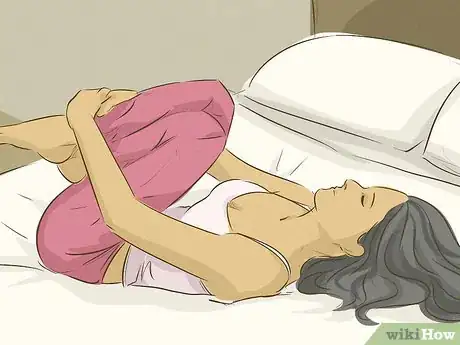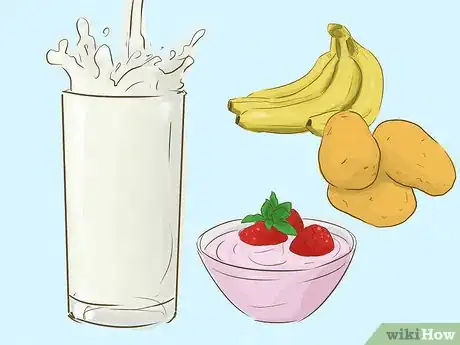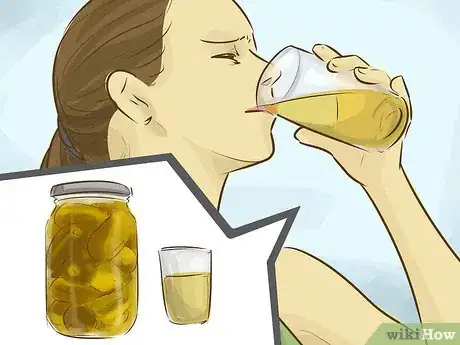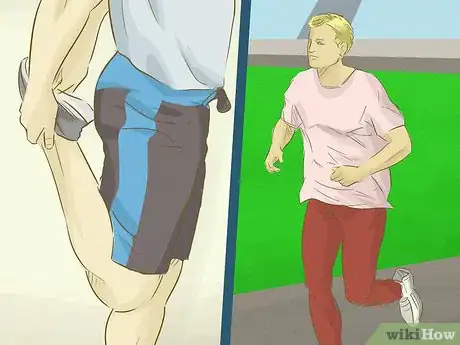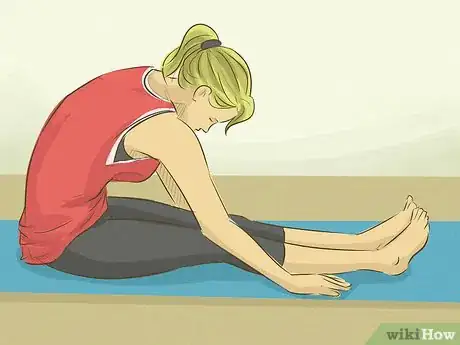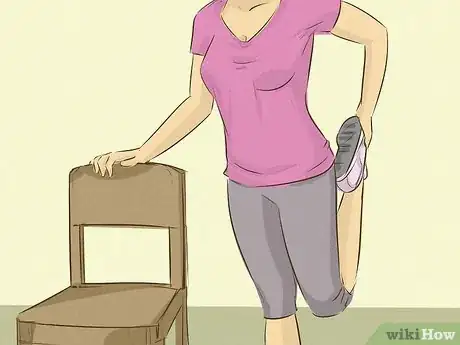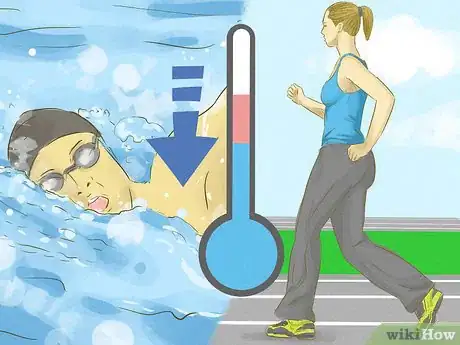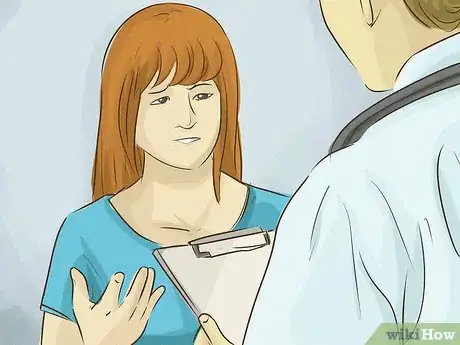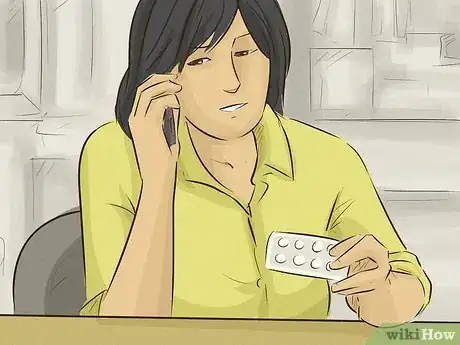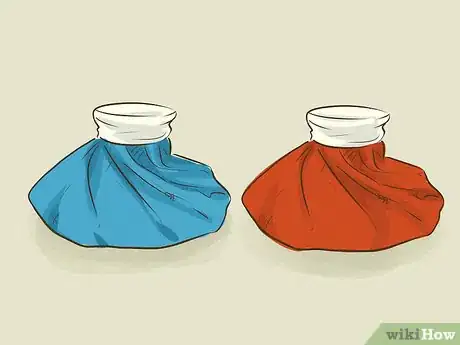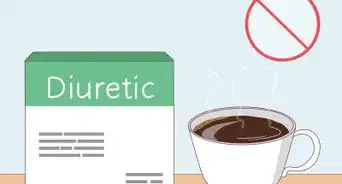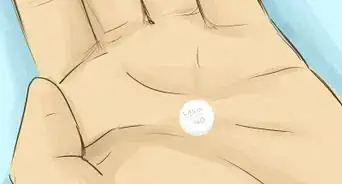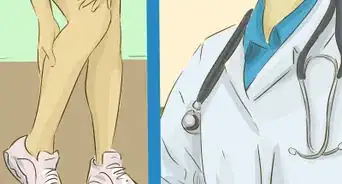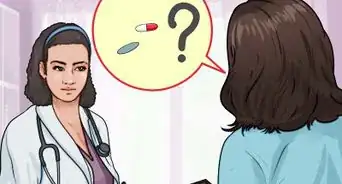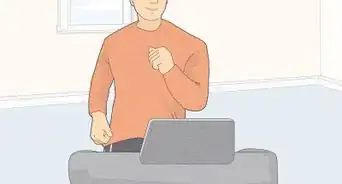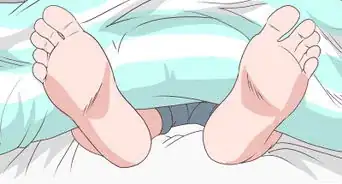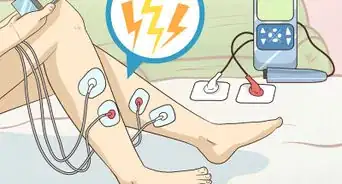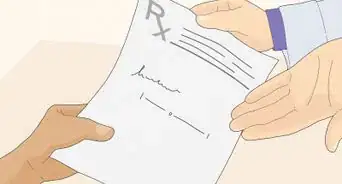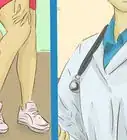This article was co-authored by Scott Anderson, MA, ATC, SFMA, DNSP. Scott Anderson is the Chief Clinical Officer at SyncThink, an award winning startup founded out of Stanford University. Scott previously served as the Director of Sports Medicine/Athletic Training for Stanford University for over ten years from 2007 to 2017. Scott has over 18 years of clinical and management experience, and is a recognized international speaker on topics of clinical specialization, which include developmental kinesiology, neuroscience/concussion, and movement dysfunction. He is a certified Dynamic Neuromuscular Stabilization Practitioner (DNSP), Sports Safety Specialist and is certified to conduct Selective Functional Movement Assessments (SFMA), and Functional Movement Screenings (FMS). He earned a BS in Athletic Training from Washington State University in 2000 and an MA in Athletic Administration from Saint Mary's College in 2002.
There are 8 references cited in this article, which can be found at the bottom of the page.
This article has been viewed 51,131 times.
Muscle cramps occur when muscles contract by force and without notice. It usually takes a couple of seconds for the muscle to finally relax, but the pain during a cramp can be extensive. To prevent muscle cramps, change your overall lifestyle. Get more calcium and potassium and drink more water. Alter your workout routine with warm ups and cool downs if you experience muscle cramps during exercise. See a doctor if your muscle cramps are severe.
Steps
Making Lifestyle Changes
-
1Drink more water. Proper hydration is key to preventing muscle cramps. If you're prone to muscle cramps, you may not be getting enough water. Work on upping your water intake throughout the day.[1]
- Start off your day with a glass of cold water.
- Carry a water bottle with you to work or school. Sip it throughout the day.
- Take advantage of water fountains. Each time you see a water fountain, stop and take a sip.
- If you dislike the taste of plain water, try flavoring water naturally with fruit and vegetables.
-
2Stretch or exercise your muscles before bed. Many people experience cramps in bed. If you're prone to leg cramps during the night, make sure to give your legs a good stretch before getting into bed.[2]
- Some light exercise before bed can also help stretch muscles and prevent cramps. Go for a light jog or walk before bed or ride a stationary bike for a few minutes.
Advertisement -
3Consume more calcium and potassium. A lack of calcium or potassium in the diet can potentially cause muscle cramps. Upping your intake of both may help prevent cramps.[3]
- Go for low-fat dairy to increase your calcium intake. Opt for things like yogurt and skim milk.
- To get more potassium, get foods like turkey, bananas, potatoes, and orange juice.
-
4Drink pickle juice. While further studies are needed to confirm this, some evidence indicates drinking pickle juice can help with muscle cramps. It's possible that pickle juice affects nerves in the stomach and throat, which can send out signals that disrupt muscles and cause cramps. If you don't mind the taste of pickle juice, you could try drinking it to see if it lessens cramping.[4]
Altering Your Workout Routine
-
1Warm up before a workout. You should never jump into a strenuous workout without a warm up. This will greatly increase your risk of a muscle cramp. To prevent cramps, do a light warm up before engaging in a full workout.[5]
- Warming up means engaging in light physical activity for five to 10 minutes before you begin a vigorous workout.
- Warm up activities are usually slower versions of your main form of exercise. To warm up for a run, for example, walk briskly for five minutes.
-
2Stretch your calves. Before aerobic activities, such as running, make sure to give your calves a good stretch. This can reduce the risk of cramping in this area.[6]
- Place one leg in front of another and then lean against a wall.
- Bend the knee of your leg closer to the wall. While you do this, stretch your back leg behind you and point the heel towards the floor. Hold this stretch for at least 20 seconds. Any less than 20 seconds will not be enough time for your calf muscles to stretch out.
- Repeat with the other leg.
-
3Target your hamstrings with stretches. You should also stretch your hamstrings if you do any exercises that use those muscles. To start, sit on the ground with your back straight and stretch both legs out in front of you.[7]
- Place your hands on the floor with the palms facing downward.
- Slide your hands forward until you feel a stretch. Then, hold this for 30 seconds.
-
4Stretch your quads. Your quads should be stretched before any workout that uses them. To start, stand next to a wall or chair and hold onto it for balance.[8]
- Lift up one foot, moving your heel towards your buttocks, and then grab your heel with your hand.
- Hold this position for 30 seconds. Then, repeat with the other leg.
-
5Cool down after a workout. After a workout, you should have a period where you cool down before stopping. A cool down involves engaging in slightly less strenuous exercise for five to 10 minutes. It's essentially the same as warming up, but you do it after finishing a workout.[9]
- For example, you can walk for 10 minutes after a run or do some slow swimming for five minutes after an intense swim.
- To prevent sore or cramping muscles, try taking a recovery day after a strenuous workout. Yoga or Pilates can be good forms of exercise on days you are looking to rest your muscles a little bit.[10]
-
6Avoid swimming until you've resolved issues with cramps. It can be very dangerous to swim if you're at risk for a muscle cramp. Therefore, you should avoid swimming, especially in large bodies of water like the ocean, until your muscle cramps are infrequent. If you're having severe cramps with no apparent cause, talk to your doctor before you attempt swimming.
Treating Muscle Spasms
-
1See a doctor under certain conditions. Muscle spasms are usually not a sign of a serious medical issue. However, under some conditions, medical intervention is necessary. See a doctor if your muscle cramps: do not have an obvious cause, like strenuous exercise; are severe; last for a long time; or happen frequently.[11]
- Your doctor will ask for your medical history and a detailed account of your symptoms.
- Your doctor may want to run some tests, such as blood work, if they suspect an underlying cause like circulation issues.
-
2Try anti-inflammatory medications. Over-the-counter anti-inflammatory medications can be used to treat muscle cramps if you experience them. In rare cases, however, a healthcare provider may prescribe medication for severe cramps.[12]
- If you are currently on medication, always check with a doctor or pharmacist to make sure your current meds will not interact poorly with over-the-counter medications.
-
3Apply heat or cold. Heat and cold can be used to soothe pain caused by muscle cramps. Press a warm or hot towel over the area that's cramping as symptoms persist. You can also massage the muscle with ice if necessary.[13]
Expert Q&A
-
QuestionHow can I prevent cramping or straining my muslces?
 Julian Arana, M.S.eD., NCSF-CPTJulian Arana is a Personal Trainer and the Founder of B-Fit Training Studios, a personal training and wellness set of studios based in Miami, Florida. Julian has over 12 years of personal training and coaching experience. He is a certified personal trainer (CPT) by the National Council on Strength and Fitness (NCSF). He has a BS in Exercise Physiology from Florida International University and an MS in Exercise Physiology specializing in strength and conditioning from the University of Miami.
Julian Arana, M.S.eD., NCSF-CPTJulian Arana is a Personal Trainer and the Founder of B-Fit Training Studios, a personal training and wellness set of studios based in Miami, Florida. Julian has over 12 years of personal training and coaching experience. He is a certified personal trainer (CPT) by the National Council on Strength and Fitness (NCSF). He has a BS in Exercise Physiology from Florida International University and an MS in Exercise Physiology specializing in strength and conditioning from the University of Miami.
Certified Personal Trainer Do some stretches, get regular massages, and use a foam roller at home. Aerobic exercises are a great choice as well. Anything you can do to get the blood flowing through the muscles will help keep them loose.
Do some stretches, get regular massages, and use a foam roller at home. Aerobic exercises are a great choice as well. Anything you can do to get the blood flowing through the muscles will help keep them loose. -
QuestionWhy do I always cramp up when it's cold out?
 Francisco GomezFrancisco Gomez is the Head Coach at the FIT Potato Gym, a training gym established in 2001 in the San Francisco Bay Area. Francisco is a former competitive runner who helps endurance athletes train for major marathons like the Boston Marathon. Francisco specializes in Injury Rehab, Flexibility, Marathon Training, and Senior Fitness. He has a B.S. in Nutrition and Exercise Physiology & Running.
Francisco GomezFrancisco Gomez is the Head Coach at the FIT Potato Gym, a training gym established in 2001 in the San Francisco Bay Area. Francisco is a former competitive runner who helps endurance athletes train for major marathons like the Boston Marathon. Francisco specializes in Injury Rehab, Flexibility, Marathon Training, and Senior Fitness. He has a B.S. in Nutrition and Exercise Physiology & Running.
Fitness Coach People tend to drink less water when it's cold out, and that's actually one of the main contributing factors when it comes to cramping. Just try to get well-hydrated before you head out for your run!
People tend to drink less water when it's cold out, and that's actually one of the main contributing factors when it comes to cramping. Just try to get well-hydrated before you head out for your run! -
QuestionCan a foam roller help with muscle cramps?
 Scott Anderson, MA, ATC, SFMA, DNSPScott Anderson is the Chief Clinical Officer at SyncThink, an award winning startup founded out of Stanford University. Scott previously served as the Director of Sports Medicine/Athletic Training for Stanford University for over ten years from 2007 to 2017. Scott has over 18 years of clinical and management experience, and is a recognized international speaker on topics of clinical specialization, which include developmental kinesiology, neuroscience/concussion, and movement dysfunction. He is a certified Dynamic Neuromuscular Stabilization Practitioner (DNSP), Sports Safety Specialist and is certified to conduct Selective Functional Movement Assessments (SFMA), and Functional Movement Screenings (FMS). He earned a BS in Athletic Training from Washington State University in 2000 and an MA in Athletic Administration from Saint Mary's College in 2002.
Scott Anderson, MA, ATC, SFMA, DNSPScott Anderson is the Chief Clinical Officer at SyncThink, an award winning startup founded out of Stanford University. Scott previously served as the Director of Sports Medicine/Athletic Training for Stanford University for over ten years from 2007 to 2017. Scott has over 18 years of clinical and management experience, and is a recognized international speaker on topics of clinical specialization, which include developmental kinesiology, neuroscience/concussion, and movement dysfunction. He is a certified Dynamic Neuromuscular Stabilization Practitioner (DNSP), Sports Safety Specialist and is certified to conduct Selective Functional Movement Assessments (SFMA), and Functional Movement Screenings (FMS). He earned a BS in Athletic Training from Washington State University in 2000 and an MA in Athletic Administration from Saint Mary's College in 2002.
Sports Medicine & Injury Prevention Specialist Foam rollers are a really great tool. There are 100 different ways that you can use the foam roller, but it's really particularly great for large muscle groups like your thighs and your calf.
Foam rollers are a really great tool. There are 100 different ways that you can use the foam roller, but it's really particularly great for large muscle groups like your thighs and your calf.
References
- ↑ http://www.mayoclinic.org/diseases-conditions/muscle-cramp/manage/ptc-20186098
- ↑ http://www.mayoclinic.org/diseases-conditions/muscle-cramp/manage/ptc-20186098
- ↑ http://www.prevention.com/fitness/fitness-tips/muscle-cramps
- ↑ http://well.blogs.nytimes.com/2010/06/09/phys-ed-can-pickle-juice-stop-muscle-cramps/
- ↑ Shira Tsvi. Personal Trainer & Fitness Instructor. Expert Interview. 7 January 2020.
- ↑ http://orthoinfo.aaos.org/topic.cfm?topic=A00200
- ↑ http://orthoinfo.aaos.org/topic.cfm?topic=A00200
- ↑ http://orthoinfo.aaos.org/topic.cfm?topic=A00200
- ↑ http://www.mayoclinic.org/healthy-lifestyle/fitness/in-depth/exercise/art-20045517?pg=2
- ↑ Scott Anderson, MA, ATC, SFMA, DNSP. Sports Medicine & Injury Prevention Specialist. Expert Interview. 24 March 2020.
- ↑ http://orthoinfo.aaos.org/topic.cfm?topic=A00200
- ↑ https://medlineplus.gov/ency/article/003193.htm
- ↑ http://www.mayoclinic.org/diseases-conditions/muscle-cramp/manage/ptc-20186098
- ↑ Scott Anderson, MA, ATC, SFMA, DNSP. Sports Medicine & Injury Prevention Specialist. Expert Interview. 24 March 2020.
- ↑ Scott Anderson, MA, ATC, SFMA, DNSP. Sports Medicine & Injury Prevention Specialist. Expert Interview. 24 March 2020.
- ↑ Scott Anderson, MA, ATC, SFMA, DNSP. Sports Medicine & Injury Prevention Specialist. Expert Interview. 24 March 2020.
About This Article
To prevent muscle cramps, try drinking plenty of water throughout the day to stay hydrated. Calcium is also important for preventing muscle cramps, so try consuming more low-fat dairy, such as yogurt and skim milk. If you get muscle cramps after exercising, make sure to warm up for five to ten minutes before working out to ease your muscles into the exercise. Similarly, you should stretch your calves before any aerobic exercise to reduce the risk of cramping. You can do this by leaning against a wall and bending each leg in turn for at least 20 seconds to stretch the opposite leg. For more tips from our Personal Trainer co-author, including how to treat muscle spasms, read on!

